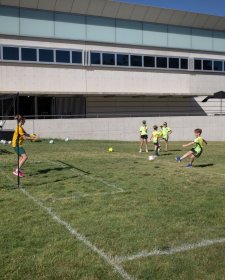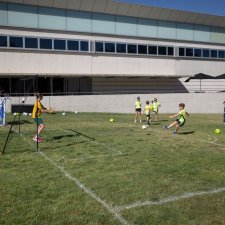[Mathew] - I'm tuned into that thing of looking for things in people and I can see things in people's faces and I could just see so much in Catherine's face and oh that is just, I could just see it all.
[Catherine]- So what would have happened if you hadn't liked my face? What would you have done?
[Mathew] - I think that I would always find a way, but in this circumstance it was just instant.
- [Interviewer] And do you work from photographs?
[Mathew]- Yes, photographs, and then we'll have sittings with the painting, so I'll bring it down here, which would be tricky to get this here but we'll be able to do it, and just have a couple of sittings with it, you know, some sittings with the painting. So I've developed a way of working which is very much when I'm with someone I just like to mostly talk and just sort of suck up things as it were, and then I'll just sort of replay that when I'm back up in the studio. My portraits are like this because I want the face and the body language for me is enough, I actually don't really want to know that much about my subject before I meet them. I want to get everything by intuition and then see how that kind of plays out. There's so much there, there's just a universe there. And I can't even contemplate putting anything else in there that could tell more of a story than what's going on in the subtleties of the body language and what I can see in someone's face. I don't even have to think very much, I'm operating on that kind of level of just feeling my way along and It's like I feel in sync with Catherine and it's just funny how those things happen.
[Catherine]- Well when I saw the various options for artists it was just instant.
[Mathew]- Right
[Catherine]- I didn't have to think about the others, yours was the style and the approach. It wasn't too busy, it wasn't trying to be complex, but there was a depth there. I was very nervous about what it was going to look like and I was so relieved when you sent through the first That's right. That's good.
- We're on the right track - Yep, Yep
- I mean I look at someone's face straight away and then I looked you, I wasn't aware of what you looked like,
- Right - and I just looked you up and then bang, straight away. My approach is really, it's very collaborative. I would never come in and say "This is what you're going to look like". Part of the process for me, part of the interesting thing for me is what people think they look like too.
[Catherine] - You're in the artist's hands. You can't be saying how, I mean I can have a little comment here and there, but no the way it works you can't be interfering with it, you'd compromise the whole structure and the whole design.
[Mathew]- Not that you want to think too consciously about that, but there are other really important things that you need to be open to and to think about, so there are a lot of universal things that are really important in who Catherine is, what she's done, how she's got to where she has, the way she has, there's the personal, there's the kind of universal, its a multidimensional thing that we do when we work on a portrait and we just have to be open to those things and what that portrait can do in the future, what it can say to people.
[Catherine]- And actually that was Mat's point, that you have to think about something that's going to be enduring, and not just for the moment or the present, and I think that was an important point.













